stripes
Ningi-Burra is the largest of the Nigerian ring-complexes covering an area of 1242 km2 and with an east-west length of 70 km. It consists of overlapping ring structures the most westerly, and youngest, of which is in contact with the Tibchi complex (No. 122-00-010). It may also be divided into three main topographical units: namely, and from east to west, the Ningi, Kah and Burra massifs (Turner and Bowden, 1979). A general sequence of igneous activity has been determined (Turner and Bowden, 1979) which is wholly or partly represented at all centres. A pre-caldera stage involved the eruption of basalt, trachybasalt, trachyte, rhyolitic ash-fall tuffs and ignimbrites which was followed by a caldera-forming stage during which thick sequences of crystal-rich rhyolitic ignimbrites accumulated in the calderas and granite porphyry ring-dykes were emplaced. During the post-caldera stage syenite and peralkaline and biotite granites were intruded. The rhyolitic rocks include voluminous ignimbrites, ash-fall tuffs and agglomerates and minor lava. The ignimbrites encompass welded and non-welded varieties and range from finely crystalline, devitrified rocks, in which are preserved shards and fiamme, to coarser rocks with a groundmass quartz-feldspar mosaic. Many of these rocks are comenditic or pantelleritic with arfvedsonite, biotite and fluorite. In Centre 6 the ignimbrites contain up to 45% of feldspar and mafic phenocrysts, the latter replaced by small aegirine crystals, in a groundmass of quartz, alkali feldspar, aegirine, arfvedsonite, which may be poikilitic, fluorite and occasional poikilitic astrophyllite. The rhyolite lavas, which are difficult to recognise, are found amongst pre-caldera stage volcanics in Centres 1, 2 and 6 (Turner and Bowden, 1979). They have variable contents of feldspar and quartz phenocrysts and iron oxide pseudomorphs are probably after fayalite and hedenbergite. Basaltic rocks are mainly confined to the lowest part of the volcanic succession with only a few interbedded with later intra-caldera rhyolites. They are always altered, with olivine and pyroxene replaced by amphibole, biotite and other phases, although primary plagioclase phenocrysts may persist. Trachyandesites are similarly altered as are trachytes and mugearites, which in one area reach a thickness of at least 200 m. The intrusive rocks are generally equivalent to the volcanics except that there are no basic intrusions, apart from some small dykes. Rock types represented include syeno-monzonite with plagioclase (An35) cores to alkali feldspar, augite, hastingsite and a little arfvedsonite. Peralkaline granites are characterised by the presence of arfvedsonite while biotite granites are extensively altered to quartz-siderophyllite greisens. Granite porphyries contain quartz, alkali feldspar, fayalite and hedenbergite phenocrysts with hastingsite or arfvedsonite in the groundmass. Ike (1985) has described from the southwestern part of the ring-dyke of Centre 6, the most westerly ring, quartz porphyry with about 50% phenocrysts of quartz, perthite, ferrohedenbergite and relict fayalite; acicular arfvedsonite grows on the ferrohedenbergite phenocrysts and is in turn overgrown by aenigmatite, and both these minerals are also present as acicular clusters in the groundmass. Analyses of this rock and of ferrohedenbergite, arfvedsonite and aenigmatite are given by Ike (1985). Detailed accounts of the geology, succession and igneous events at each of the six centres are given by Turner and Bowden (1979) and Bennett et al. (1984) and on the coloured geological map accomanying the former paper more than 50 igneous units are distinguished.
BENNETT, J.N., TURNER, D.C., IKE, E.C. and BOWDEN, P. 1984. The geology of some northern Nigerian anorogenic ring complexes. Overseas Geology and Mineral Resources, 61: 1-65.IKE, E.C. 1985. Postmagmatic arfvedsonite-aenigmatite paragenesis in the ring-dyke of the Burra Centre, Ningi-Burra complex, Nigeria. Journal of African Earth Sciences, 3: 101-5.RAHAMAN, M.A., VAN BREEMEN, O., BOWDEN, P. and BENNETT, J.N. 1984. Age migrations of anorogenic ring complexes in northern Nigeria. Journal of Geology, 92: 173-84.TURNER, D.C. and BOWDEN, P. 1979. The Ningi-Burra complex, Nigeria: dissected calderas and migrating magmatic centres. Journal of the Geological Society, London,136: 105-19.

